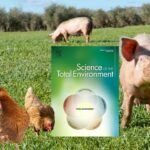
Risks associated with copper and copper oxide nanoparticles

News
+ Info sheets
Agenda
By the AVICENN team – Last modification December 2025
Risks associated with copper and copper oxide nanoparticles
Copper and copper oxide nanoparticles are used for their antibacterial and antifungal properties, for example in pesticides, as well as a growth promoter in agricultural fertilizers and livestock feed (outside the European Union).
What about environmental and health risks?
Data are still very patchy, but caution is necessary due to their possible accumulation in certain organs – notably the liver and spleen – as well as potential mutagenic/genotoxic and immunotoxic/nephrotoxic effects1See Opinion on Copper (nano) and Colloidal Copper (nano), Scientific Committee on Consumer Safety (SCCS), March 2021.
Bibliography
Explore the bibliography below to learn more:
Bibliography Nanocopper and Risks
- In French :
- Copper nanoparticles in agriculture: a precautionary approach is needed, AVICENN @VeilleNanos, December 2025
- Understanding the cytotoxicity of metallic nanoparticles, CNRS, March 2021
- Antibacterial effects of copper, copper oxide and iron oxide nanoparticles, Myriam Talantikit, Institute of Biomedical Engineering, École polytechnique de Montréal, 2014
- In English:
- Copper nanoparticles in agriculture: from expected benefits of reduced copper use to toxicity on gut health, Casale E et al., Science of the Total Environment, 1004, 15 November 2025
- (…)
- Ecotoxicity of as-synthesized copper nanoparticles on soil bacteria, IET Nanobiotechnology, Sharma P et al, March 2021
- Opinion on Copper (nano) and Colloidal Copper (nano), Scientific Committee on Consumer Safety (SCCS), March 2021
- Exposure to copper oxide nanoparticles triggers oxidative stress and endoplasmic reticulum (ER)-induced toxicology and apoptosis in male rat liver and BRL-3A cell, Liu H et al, Journal of hazardous materials, 421, 2021
- ZnO and CuO nanoparticles: a threat to soil organisms, plants, and human health, Rajput V et al, Environmental Geochemistry and Health, 42: 147-158, 2020
- Rainbow trout (Oncorhynchus mykiss) chemosensory detection of and reactions to copper nanoparticles and copper ions, Razmara P et al, Environmental Pollution, 260, May 2020
- Epigenetic effects of (nano)materials in environmental species – Cu case study in Enchytraeus crypticus, Bicho RC et al, Environment International, 136, March 2020
- Copper Nanoparticles Mitigate the Growth, Immunity, and Oxidation Resistance in Common Carp (Cyprinus carpio), Dawoo M et al, Biological Trace Element Research, 5 February 2020
- Effects of copper oxide nanoparticles on the Chlorella algae in the presence of humic acid, Fathi P et al, SN Applied Sciences, 1 January 2020
- Copper nanoparticles induce zebrafish intestinal defects via endoplasmic reticulum and oxidative stress, Zhao G. et al, Royal society of chemistry, 28 November 2019
- Assessment of Cu and CuO nanoparticle ecological responses using laboratory small-scale microcosms, Fan Wu, Bryan J. Harper, Lauren E. Crandon, Stacey L. Harper, Royal society of chemistry, 20 November 2019
- Effects of Copper Oxide Nanoparticles (CuO-NPs) on Parturition Time, Survival Rate and Reproductive Success of Guppy Fish, Poecilia reticulata, Mohammad Forouhar Vajargah et al, Journal of Cluster Science, 7 September 2019
- Interaction of copper-based nanoparticles to soil, terrestrial, and aquatic systems: critical review of the state of the science and future perspectives, Rajput V et al, Reviews of Environmental Contamination and Toxicology, 252: 51-96, 2019
Any questions or comments? This information sheet compiled by AVICENN is intended to be completed and updated. Please feel free to contribute.
Other news on the topic
Our information sheets to go further
Upcoming Nano Agenda
27
Jan.
2026

Nanotechnologies and agriculture: a reference framework for responsible practice (AFNOR, online)
On line
Webinar
- Webconference for analysis laboratories, plant fertilizer manufacturers and distributors, public authorities…
- Moderated by David Krupka, nanotechnologies development manager at AFNOR Normalisation and Emilie Langlois-Bertrand, nantechnologies standardization project manager.
- In partnership with Armand Masion, CNRS Research Director, and Sandrine Mocoeur, Health, Safety, Environment and Quality Manager at SYNGENTA.
- This exchange will also be an opportunity to explore the creation of a national platform to identify standardization needs.
- Website: www.afnor.org/evenement/nanotechnologies-agriculture-cadre-pratique-responsable/
2
Juin
2026
Emerging pathologies and risks (CNMST 2026, Lyon – France)
Lyon
Congress
- 8th Congress of Occupational Medicine and Health (CNMST 2026)
- Theme 5: Emerging pathologies and risks, Mr Henri Bastos (ANSES), Pr Lynda Bensefa-Colas (AP-HP), Dr Catherine Nisse (CHU Lille)
- Website: www.medecine-sante-travail.com
26
Juin
2026
Nanomaterials and Health (ANSES, Maisons-Alfort)
Maisons-Alfort
Dialogue Committee
- 20th meeting of the “nano and health” dialogue committee
- Organizer: ANSES
This file was originally created in May 2020
Notes and references
- 1See Opinion on Copper (nano) and Colloidal Copper (nano), Scientific Committee on Consumer Safety (SCCS), March 2021



